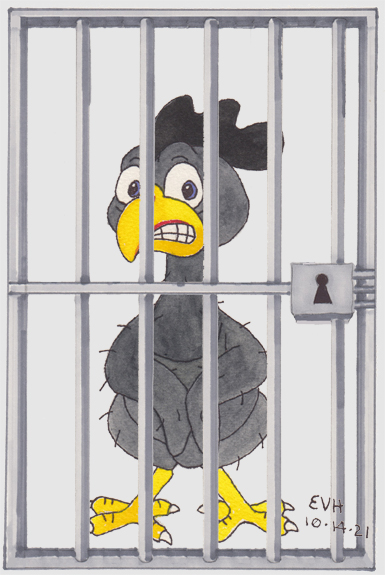
Jataka 274
Lola Jātaka
The Story of Greed
as told by Eric Van Horn
originally translated by William Henry Denham Rouse, Cambridge University
originally edited by Professor Edward Byles Cowell, Cambridge University
This is fundamentally the same story as Jātaka 42.
One of the themes in the Buddha’s teaching is how ignoble behavior leads to suffering among victims of the perpetrator, but it also leads to suffering of the perpetrator. This type of suffering is sometimes subtle. For example, the billionaire who is never satisfied and always needs more and more and more, that is someone who leads the life of a hungry ghost. They live a life of constant wanting and never being satisfied. Compare that to the images of the Buddha. He is always calm, serene, and contented. He never needs anything more than the most basic necessities of life in order to be happy.
“Who is this tufted crane?” The Master told this story while he was at Jetavana. It is about a greedy monk. This monk was brought to the Dharma Hall. There the Master said, “It is not only now that he is greedy. He was greedy before, and his greed cost him his life. And because of him wise men of old were driven out of house and home.” Then he told them this story from the past.
Once upon a time, when Brahmadatta was King of Benares, a rich merchant’s cook of that town hung up a nest-basket in the kitchen to gain merit from it. (The merit was earned because he performed an act of generosity.) The Bodhisatta at that time was a pigeon, and he came and lived in it.
Now as he flew over the kitchen, a greedy crow was attracted by the fish that lay there. He hungered after them. “How in the world can I get some?” he thought. Then he saw the Bodhisatta. “I have it!” he thought.” I’ll make this creature into my stooge.” And this is how he determined to proceed.
When the pigeon went out to seek his day’s food, behind him—following, following—came the crow.
“What do you want with me, Mr. Crow?” said the Pigeon. “You and I don’t eat the same things.”
“Ah, but I like you,” said the crow. “Let me be your humble servant and eat with you.”
The pigeon agreed. But when they went feeding together, the crow only pretended to eat with him. Every so often he would turn back, peck at some lump of cow-dung, and get a worm or two. When he had had his fill, up he flew. “Hello, Mr. Pigeon! What a long time you take to eat your meal! You never know where to draw the line. Come, let’s go back before it is too late.” And so they did. When they got back, the cook, seeing that their pigeon had brought a friend, hung up another basket.
This is the way things went for four or five days. Then a great supply of fish arrived at the rich man’s kitchen. How the crow longed for some! Now was the time for him to play his trick.
On the next morning, he lay there, groaning and making a great noise. The pigeon said to the crow, “Come along, old fellow. It is time for breakfast!”
“You can go,” he said. “I have a terrible stomach ache.”
“A crow with indigestion? Nonsense!” said the pigeon. “Even a lamp-wick hardly spends any time in your stomach, and you digest anything else you digest in a flash as soon as you eat it. Now you do what I tell you. Don’t behave in this way just because you see a little fish!”
“Why, sir, what are you saying? I tell you, I have a bad pain inside!”
“All right, all right,” said the pigeon. “Take care.” And away he flew.
The cook got all the dishes ready. Then he stood at the kitchen door, mopping the sweat off himself. “Now is my time!” thought Mr. Crow. He flew onto a dish with some dainty food in it. Click! The cook heard the noise and looked around. Ah! In a twinkling he caught the crow. He plucked off all his feathers except for one tuft on the top of his head. Then he powdered ginger and cinnamon, mixed it up with buttermilk, and rubbed it all over the crow’s body. “That’s for spoiling my master’s dinner and making me throw it away!” he said. Then he threw him into his basket. Oh, how it hurt!
By and by the pigeon came back from his hunt. The first thing he saw was our crow. The pigeon created quite a fuss. What fun he made of him, to be sure! He dropped into poetry as follows:
“Who is this tufted crane I see
Where she has no right to be?
Come out! My friend the crow is near,
Who will do you harm, I fear!”
To this the crow answered with another verse:
“No tufted crane am I, no, no!
Nothing but a greedy crow.
I would not do as I was told
So I am plucked, as you behold.”
And the pigeon responded with a third verse:
“You’ll come to grief again, I know,
It is your nature to do so.
If people make a dish of meat,
‘Tis not for little birds to eat.”
Then the pigeon flew away, saying, “I can’t live with this creature.” And the crow lay there groaning until he died.

Figure: Caught!
When the Master had ended this discourse, he taught the Four Noble Truths, at the conclusion of which the greedy monk attained the fruit of non-returning. The he identified the birth, “The greedy monk in those days was the crow, and I was the pigeon.”
